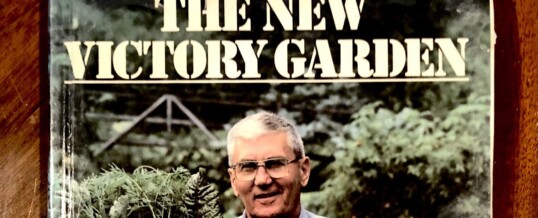
They were called, “Victory Gardens.” And they were one of the weapons US citizens used to help win World War II.
With the bad guys throwing everything at us that they could, in return, we were throwing everything at them that we could.
What we were throwing was in the shape of bullets, bombs, aircraft, and tanks, all of which cost a lot of money.
With the military needing all of the commercially grown food for the troops, the president asked Americans to plant a garden. One that could feed their own family. Most country folks were already growing their own food. They had to for survival. But even more Americans began growing their own food, and kept growing it long after the war ended.
Even a dozen or so years after World War II ended, folks in my hometown of Ashdown, Arkansas, still had a Victory Garden.
So, all I ever knew as a kid was that you had a garden. It became routine for me.
Routine brings comfort. But it can also bring complacency — and a misplaced sense of security. Which is what’s happened to America since the Victory Gardens have faded away.
Just as I grew up with the next meal just outside of my back door, folks today think their next meal is just inside the nearest supermarket.
The reality is that millions of Americans live near a grocery store, but nowhere near where the food that’s in it originates. And that could be a problem.
In some ways, it already is.
Why do we have a $7.50 price tag on Tony The Tiger’s cereal? Many reasons, but one of the main ones is the cost of fuel. Back in the late 1970s and early 1980s we suffered a very similar problem. Interest rates climbed and so did the cost of things. That included gasoline and diesel.
It takes one or the other to bring vegetables, meat, and other foods from the farms to the processing plants. Then, it takes more fuel to get the finished grocery items to your favorite grocer’s shelves.
So, it just makes sense that if we lessened our dependence on something someone else grows or raises, we would save a lot of money, and have the excellent convenience of having some or all of a menu item right in our own back yard.
How does one get started if you’ve never had or helped with a garden? Well, the first thing to note is that it’s a whole lot easier to grow your own food today than it was when Lyndon Johnson was president. That’s when my parents were teaching my sister and me.
Then, we had the expertise of those in the family who had learned from their predecessors. Today, we have our predecessors (although, in many cases there are fewer of them who ever learned to garden), but we also have the Internet. The World Wide Web.
And people love to share their knowledge.
YouTube is a free video service that includes just about any type of homemade video you can think of. Sure, there’s some content out there that’s offensive and not what you want, but you quickly learn how to find and avoid things you don’t want to see.
And just as quickly, you learn how to find and lock on to things you do want to see.
Books on gardening can be ordered. Classes can be signed up for and attended. My wife took a week and went to Kansas to learn from a man and his family. They’d mastered a method of gardening that’s almost 100 years old, and is now tried and true.
My wife and I have a 10-acre homestead. We have an area around the house where we have our garden. Actually, I should say gardens. The different plots of land focus on certain types of vegetables, herbs, fruits, and nuts.
All of which we plant, nurture, and harvest using the wisdom that was passed down to us by our parents, grandparents, and even great grandparents.
Our venture into gardening was an unlikely one. Like many people today, we could get whatever we wanted from the supermarket, so we didn’t worry at all about growing anything.
But two things changed that: My desire to have the same kind of red potatoes to eat that my grandmother used to grow, and a radio show I’d discovered and listened to each Saturday morning.
The show was on a Dallas radio station and was hosted by Howard Garrett, also called, “The Dirt Doctor.” Mr. Garrett uses no chemicals or pesticides (just as my grandparents and great grandparents had gardened), so that’s how I decided to garden.
Before we moved to the country, there had been a plot of land behind our house in town that had been filled with rocks. After clearing out the rocks, I tilled up the already-disturbed part of the lawn and planted my red potatoes. My granny called them, “seed potatoes.”
An amazing crop convinced us to expand our efforts. When we moved to our homestead, we just kept expanding.
Today, my wife grows about 65% of our vegetables. We freeze, can, or eat them fresh.
Even bigger than the satisfaction of enjoying a fresh garden tomato in the spring or a jalapeño in a pot of chili, is knowing that we aren’t counting on someone somewhere else, far away, to make sure we have something to eat tomorrow. Next week. Or next year.
My entire life, people have said how bad the world is getting. And they’re right.
All the more reason to keep our victories close. In our own hands. In our own backyards.
©2023 John Moore
John’s books, Puns for Groan People and Write of Passage: A Southerner’s View of Then and Now Vol. 1 and Vol. 2, are available on his website – TheCountryWriter.com, where you can also send him a message and hear his weekly podcast.
AUG
2023
